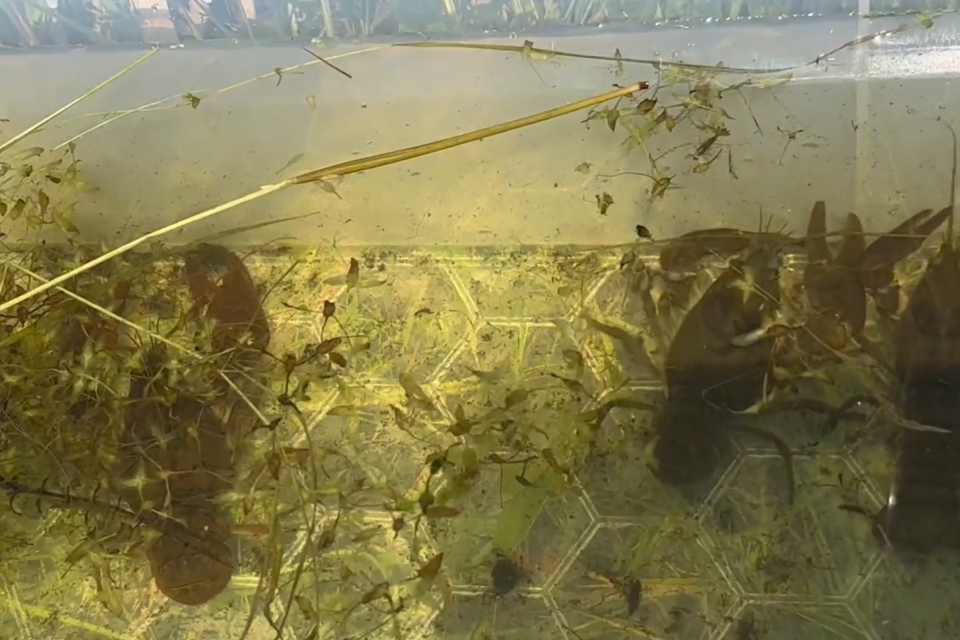Environment Agency

A rescued population of endangered white clawed crayfish that were in danger of being wiped out have been moved to a safe haven at the University of Leeds, where they can thrive and breed.
In April, Environment Agency biodiversity specialists rescued the population from Meanwood Beck in Leeds, where crayfish plague was detected during water sampling.
Those rescued, which included females carrying eggs, were kept for safekeeping in quarantine in tanks at York Gate Garden and the University of Leeds before passing health checks to ensure they were plague free.
Most have now been released into Bodington Pond at the University of Leeds where they can thrive and breed before being released back into the wild.
The rescue and release is part of work by the Environment Agency and partners to carry out operations to rescue the native species after the invasive American Signal crayfish and a disease it carries crayfish plague moved through parts of the River Aire catchment.
In the coming weeks, officers will also carry out a rescue at Pudsey Beck, where the presence of signal crayfish have been confirmed.
We must act to preserve what we can
Environment Agency biodiversity specialist Tim Selway, who is leading the project, said:
With so few populations of native crayfish remaining, we must act to preserve what we can.
The endangered white-clawed crayfish plays a vital role in keeping our waterways clean and as a source of food for other native species, so its vital we take action to ensure its survival.
Those rescued from Meanwood Beck now have a new home where they will be safe from invasive crayfish and crayfish plague. Once native crayfish numbers increase in the pond we will be able to use them as stock for other appropriate sites.
We will continue to monitor the spread of plague in Meanwood Beck with a view to reintroducing native crayfish into the watercourse in the future.
Well be carrying out further operations to rescue more crayfish from the deadly invasive signal and the disease it carries in the coming months. In the meantime we urge people not to move crayfish from where they are found but instead report any sightings to the Environment Agency.

Crayfish released into Bodington Pond at the University of Leeds
Native species most at risk from invasive signal crayfish
Rare white-clawed crayfish are the UKs only native, freshwater crayfish, and are most at risk from the signal crayfish, which spread crayfish plague and compete for food. They have struggled to survive after the more aggressive signal crayfish population has taken hold across the country.
The Agency is working with partners including Yorkshire Water and Yorkshire Wildlife Trust to develop a network of ark sites, which are locations in catchments where invasive crayfish, and crayfish plague, are absent.
Here, native crayfish populations can be protected, away from threats. In the future, its hoped to use crayfish from these ark sites to repopulate watercourses.
At the university the crayfish will be cared for at Bodington Pond, a safe ark site.
Ann Allen, Director of Campus Innovation & Development, University of Leeds said:
Bodington Pond was originally constructed to reduce flood risk in the River Aire catchment, but it also enhances biodiversity and provides opportunities for students, academics and partners to collaborate on research projects.
Were delighted to work in partnership with the Environment Agency and colleagues across the University to welcome our brand new residents.
The Agency and university is calling for people to play their part by making sure they Check, Clean and Dry to prevent the spread of invasive species.
Alison Dunn, Professor of Ecology at University of Leeds added:
Invasive species and diseases are a growing challenge for native wildlife so its really important that everyone plays their part in reducing the risk.
The good news is there are things you can do to help stop the spread if youre near any rivers or lakes for recreation or work. Simple steps, such as checking, cleaning and drying your equipment and boots, makes a big difference to native species like the white-clawed crayfish.
Anything that has contact with the water and riverbank needs to be cleaned thoroughly, using hot tap water if possible, and dried until it has been dry for 48 hours. The use of an environmentally friendly aquatic disinfectant is also recommended. This will?make sure all aquatic diseases and invasive species are killed.
More information can be found on the Invasive non-native species website
If you see any crayfish, alive or dead, leave it where it is and report it immediately to the Environment Agency on 0800 807060. If possible, take close-up photos of the crayfish to help identify the species. It is illegal to handle or remove crayfish from the water without the correct licences. Do not move animals or plants to a new river of lake and do not use crayfish as angling bait a this could spread invas
